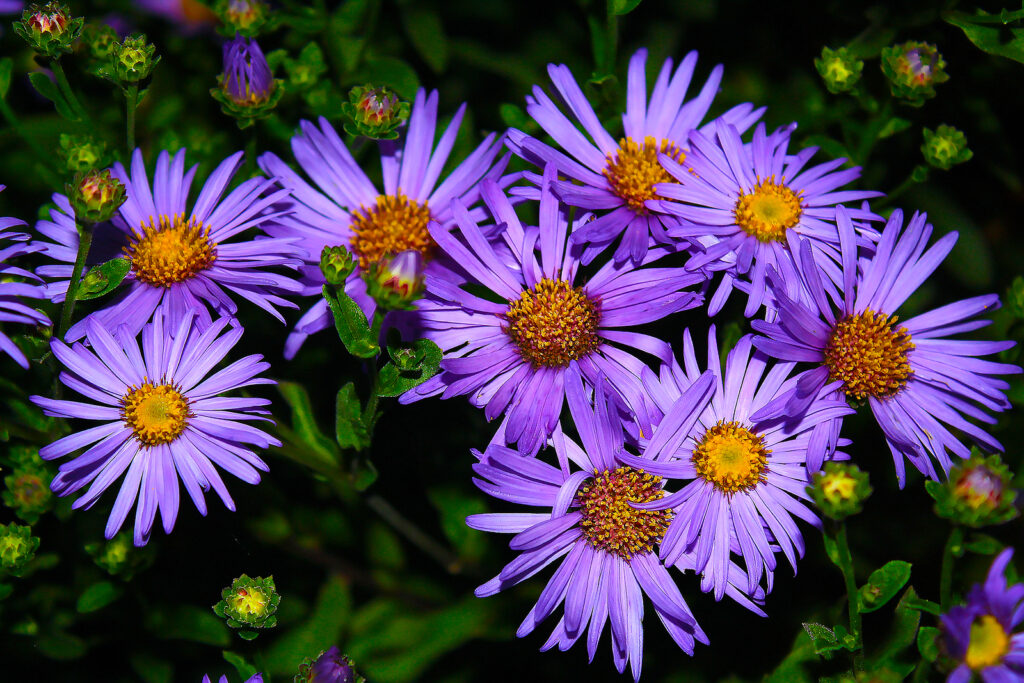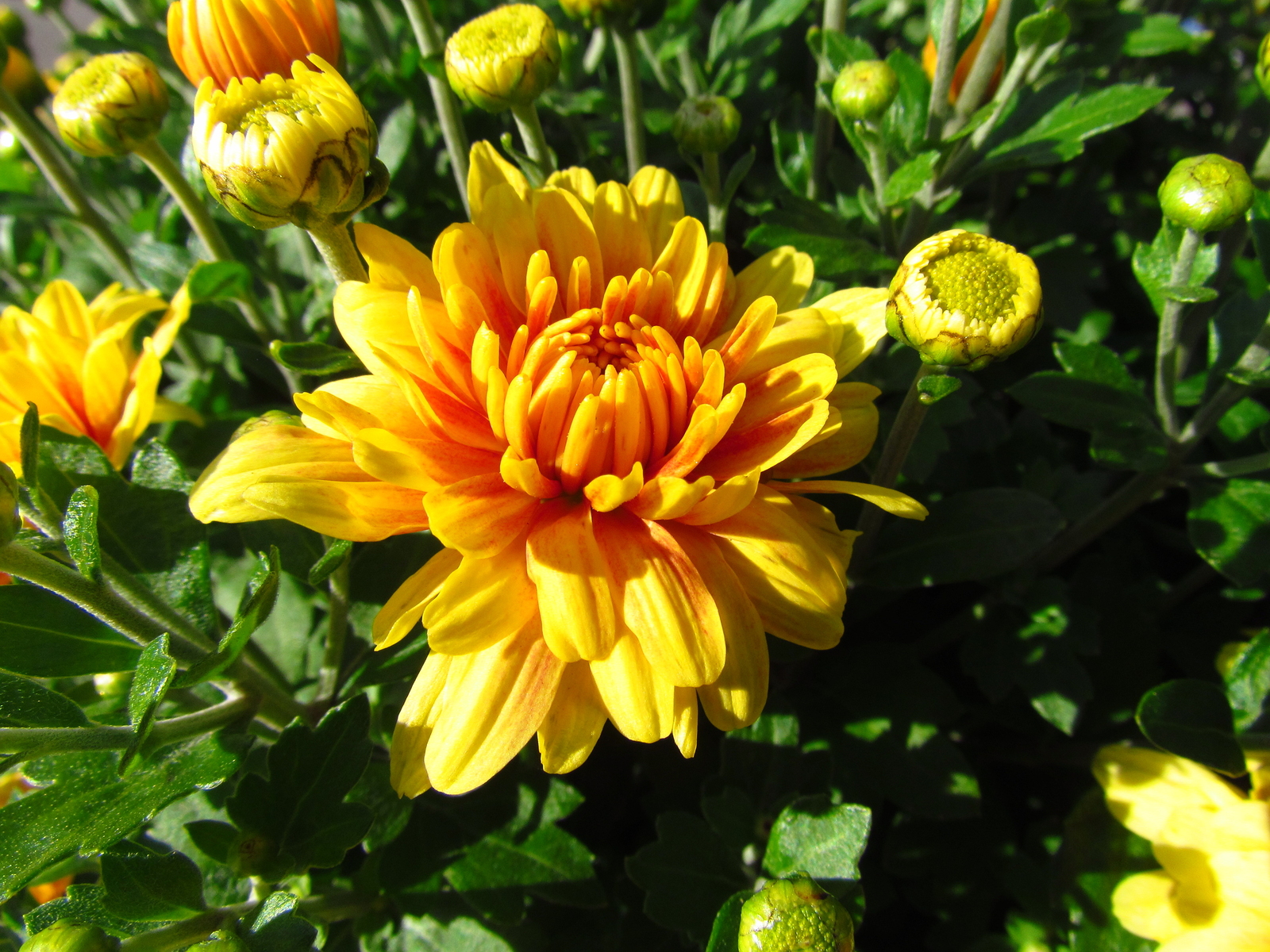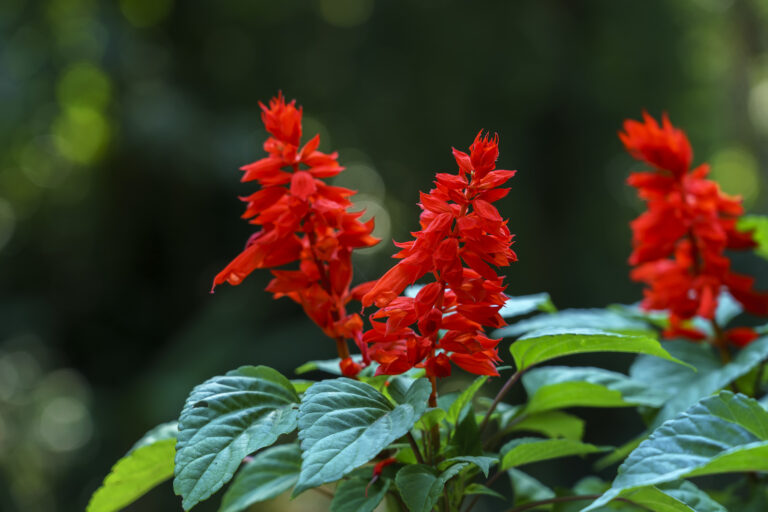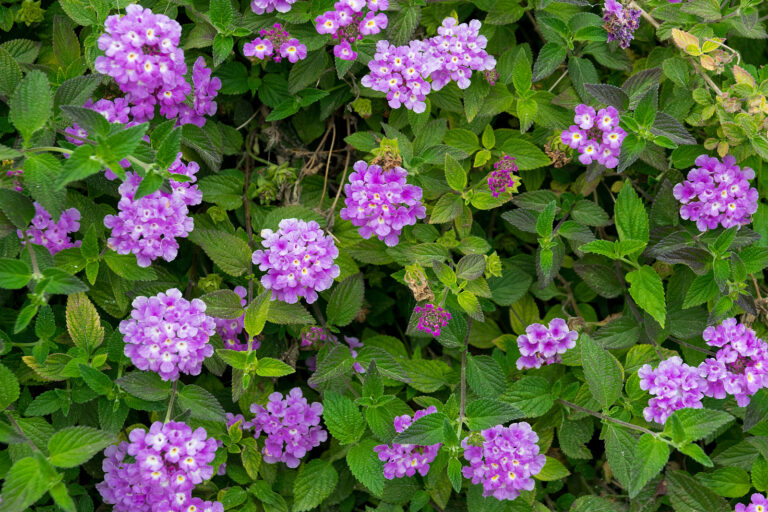Autumn Blooming Flowers
Autumn has a special effect on all plants in the garden. Annuals and perennials are one part of the whole. Many trees and shrubs will be adding their own special effects in autumn.
In selecting annuals and perennials for the autumn garden, it is necessary to know not only the overall effect your design will have but the color that each individual will contribute, and also know the sequence in which one flower will follow another in the color procession.
When choosing flowers for the autumn garden, follow the lead of Nature. Yellows, reds, purple-reds, scarlets, and bronzes are colors for autumn. These colors have a special value in autumn, even as the distinctive spring colors at the beginning of the growing season.
This list of autumn blooming flowers is aimed at gardens near 40 degrees North latitude (this latitude runs from Toms River, New Jersey, through Philadelphia, through Columbus Ohio, through Boulder, Colorado to Humboldt County in far northern California).
The list pre-supposes that snow has not fallen in autumn where you live. If you live where snow comes in autumn, you will want to look at the list of shrubs and trees for the winter garden. That list features showy bark, berries, and plants notable for their leafless form.
If annuals and perennials grow where you live in autumn, you may find that the plants on this list bloom a bit earlier or later. Gardeners further north will find that their flowers will bloom later, and gardeners to the south will have earlier blooms.
This list includes annuals, bulbs, perennials, and roses.

Flowers for autumn blooming
Aconitum, azure monkshood: Known for its striking, deep blue to purple hood-shaped flowers, Aconitum, also known as Azure Monkshood, blooms in late summer to autumn. It’s a tall perennial, often reaching heights of 3-5 feet, with glossy green leaves. All parts of the plant are highly toxic, earning it names like “Wolf’s Bane.”
Allium, garlic chives: Garlic chives have flat, grass-like leaves and small, star-shaped white flowers that bloom in late summer. The plant emits a mild garlic scent, and both the leaves and flowers are edible, often used in culinary dishes for their mild garlic flavor.
Arum, Italian arum (berries in fall): Italian Arum is a striking plant with glossy, arrow-shaped leaves and pale green spathes surrounding a spike of tiny flowers. In fall, these flowers give way to clusters of bright orange-red berries. It’s a woodland plant, often grown for its attractive foliage and fall berries.
Aster, New England aster, New York aster: These asters are tall, bushy perennials that produce masses of daisy-like flowers in late summer to fall. New England Aster flowers are typically purple or pink with yellow centers, while New York Aster can have a wider color range, including white and lavender. They are excellent for attracting pollinators.
Boltonia: Boltonia, often called false aster, is a tall, hardy perennial with abundant white or pale pink daisy-like flowers that bloom in late summer to fall. It has a bushy growth habit and is known for its long blooming period and ability to attract butterflies.
Ceratostigma, plumbago, leadwort: Ceratostigma, also known as plumbago or leadwort, is a low-growing perennial with small, vivid blue flowers that bloom in late summer to early autumn. The foliage turns a striking reddish-bronze in the fall, providing additional interest.
Cimicifuga, Kamchatka snakeroot: Cimicifuga, also known as Kamchatka Snakeroot or Bugbane, is a tall, elegant perennial that can grow up to 6 feet in height. It features long, slender spires of small, white, or pale pink flowers that bloom in late summer to early fall. The flowers emit a subtle, sweet fragrance. The plant has deeply divided, dark green foliage that adds texture to the garden. It prefers shady, moist environments and is often used in woodland or shade gardens.
Colchicum: Colchicum, commonly known as autumn crocus or meadow saffron, is a bulbous perennial that blooms in late summer or early fall. Despite its common name, it is not a true crocus. The flowers are typically pink, lilac, or white and resemble crocuses, but they are much larger, often up to 6 inches in diameter. The leaves appear in spring and die back by summer, with the flowers emerging directly from the ground later in the year. Colchicum is often planted in lawns, borders, or rock gardens.
Crocus, autumn crocus, saffron crocus: The autumn crocus, or saffron crocus, is a delicate, small flower that blooms in the fall. It features slender, purple petals and bright orange-red stigmas, which are harvested as saffron, the valuable spice. The plant is low-growing, with grass-like leaves that usually appear after the flowers. It thrives in sunny, well-drained areas and is often planted in groups for a striking display of color in the fall garden.
Cyclamen, hardy cyclamen: Hardy cyclamen is a small, tuberous perennial that blooms in late summer to fall. The flowers are usually pink, white, or magenta, with gracefully reflexed petals that give them a delicate, nodding appearance. The leaves are heart-shaped, often variegated with silver patterns, and they emerge in the fall, lasting through the winter. Hardy cyclamen is often grown in woodland gardens, rock gardens, or as ground cover under trees.
Dendrathema, garden chrysanthemum: Garden chrysanthemums, or mums, are popular fall-blooming perennials known for their bright, abundant flowers. They come in a wide range of colors, including yellow, orange, red, pink, purple, and white, and in various forms such as daisy-like, pompons, or spider shapes. Mums are compact plants with dark green, lobed leaves, and they bloom from late summer through the fall. They are commonly used in borders, containers, and as seasonal decoration.
Eupatorium, mistflower, Joe-pye weed: Eupatorium, also known as Joe-Pye Weed or Mistflower, is a tall, robust perennial that can reach up to 7 feet in height. It produces large, dome-shaped clusters of tiny, pinkish-purple flowers from late summer to fall. The flowers are highly attractive to butterflies and other pollinators. The plant has dark green, serrated leaves that grow in whorls around the stems. Joe-Pye Weed is often found in meadows, along streams, and in wildflower gardens. It prefers moist, well-drained soil and full sun to partial shade.
Gentiana, bottle gentian: Bottle gentian is a striking perennial known for its deep blue, tubular flowers that remain closed or only partially open, resembling a bottle. The flowers bloom from late summer to early fall and are pollinated primarily by bumblebees, which are strong enough to force their way into the closed petals. The plant has lance-shaped, dark green leaves and grows to about 1 to 2 feet in height. Bottle gentian prefers moist, well-drained soils and is often found in meadows, wetlands, and woodland gardens.
Helenium, H. hoopsei: Helenium hoopsei, commonly known as sneezeweed, is a hardy perennial that produces clusters of bright yellow, daisy-like flowers with prominent, dome-shaped centers. The plant blooms from late spring to early summer and typically reaches a height of 2 to 3 feet. The flowers have a warm, golden hue that adds a splash of color to gardens. Helenium prefers full sun and well-drained soil and is often used in borders, wildflower gardens, or naturalized areas.
Leucojum, autumn snowflake: Autumn snowflake, or Leucojum, is a charming bulbous perennial that blooms in late summer to early fall. It produces delicate, nodding white flowers with green-tipped petals, resembling small snowdrops. The flowers are borne on slender stems above narrow, grass-like leaves. Autumn snowflake grows to about 1 foot in height and thrives in well-drained, moist soils, making it suitable for borders, rock gardens, or woodland settings.
Lycoris, magic lily (early autumn, late summer in some places): Lycoris, commonly known as magic lily or resurrection lily, is a bulbous perennial that produces stunning, lily-like flowers in late summer or early autumn. The flowers appear on tall, naked stems after the foliage has died back, giving the plant its “magic” reputation. The blooms are typically pink, lavender, or red and have a delicate, sweet fragrance. Magic lily is well-suited to sunny, well-drained areas and is often planted in borders, woodland gardens, or naturalized areas.
Nerine, nerine lily: Nerine lily, also known as Guernsey lily, is a bulbous perennial that blooms in late summer to early autumn. It produces clusters of star-shaped, often frilly flowers in shades of pink, red, or white. The flowers are borne on tall, slender stems, and the plant’s foliage usually appears after the blooms. Nerine lilies prefer full sun and well-drained soil and are often used in borders, rock gardens, or as cut flowers due to their striking appearance and long vase life.
Oxalis: Oxalis is a diverse genus of plants, commonly known as wood sorrel or shamrock, with species that range from small ground covers to ornamental plants. They typically have trifoliate, clover-like leaves and delicate, five-petaled flowers that come in colors such as pink, yellow, white, and purple. Oxalis blooms in various seasons depending on the species, and the flowers often close at night or during cloudy weather. The plant prefers well-drained soil and partial shade and is often grown in containers, rock gardens, or as a ground cover.
Polianthes, tuberose: Tuberose is a fragrant, bulbous perennial known for its tall spikes of waxy, white, or pale pink flowers that bloom in late summer to early autumn. The flowers emit a powerful, sweet fragrance that intensifies in the evening, making them popular in perfumery and as cut flowers. Tuberose plants grow up to 3 feet in height and prefer full sun and well-drained soil. They are often used in borders, containers, or as a fragrant accent in the garden.
Salvia, azure sage: Azure sage, a member of the Salvia genus, is a striking perennial known for its tall spikes of vivid blue flowers that bloom from late summer into fall. The flowers are tubular and attract a variety of pollinators, including bees, butterflies, and hummingbirds. Azure sage has aromatic, gray-green foliage, and the plant typically grows 3 to 5 feet tall. It prefers full sun and well-drained soil, making it an excellent choice for borders, cottage gardens, or pollinator gardens.
Schizostylis, crimson flag: Schizostylis, also known as Crimson Flag or Kaffir Lily, is a late-blooming perennial that produces elegant, sword-like foliage and spikes of star-shaped flowers in shades of red, pink, or white. The flowers bloom in late summer to early autumn, providing a burst of color when many other plants are fading. Crimson Flag thrives in moist, well-drained soil and prefers full sun to partial shade. It is commonly used in borders, near ponds, or in naturalized areas.
Sedum (some species bloom in early autumn): Sedum, also known as stonecrop, is a diverse group of succulent perennials that are known for their fleshy leaves and clusters of small, star-shaped flowers. Some species, such as Sedum spectabile, bloom in early autumn, producing dense, flat-topped clusters of pink, red, or white flowers. These drought-tolerant plants thrive in full sun and well-drained soil, making them ideal for rock gardens, borders, or containers. Sedum is also valued for its ability to attract pollinators and for its low-maintenance requirements.
Sternbergia, winter daffodil: Sternbergia, commonly known as Winter Daffodil, is a bulbous perennial that blooms in late autumn, often after the first frost. The plant produces bright yellow, crocus-like flowers that resemble miniature daffodils. The flowers emerge from the ground without foliage, which appears later in the season and persists through the winter. Winter Daffodil prefers well-drained soil and full sun, making it suitable for rock gardens, borders, or as a bright accent in autumn gardens.
Tricyrtis, toad lily: Toad lily is a unique and exotic-looking perennial that blooms in late summer to early autumn. The flowers are small, orchid-like, and often speckled with shades of purple, pink, or white. They grow in clusters along the stems and are prized for their intricate patterns and unusual appearance. Toad lily has arching, hairy stems and lance-shaped leaves. It thrives in partial to full shade and moist, well-drained soil, making it a great addition to woodland gardens or shaded borders.
Urginea, ironweed, sea squill: Urginea, also known as Sea Squill or Ironweed, is a bulbous perennial native to the Mediterranean region. It is known for its dramatic flower spike that can reach up to 6 feet tall, bearing hundreds of small, white to pale pink star-shaped flowers. The plant blooms in late summer to early autumn, often before the foliage appears. Sea Squill is drought-tolerant and prefers full sun and well-drained soil. It is commonly found in coastal gardens, rock gardens, or dry landscapes.
Yucca, Spanish dagger (warm climates): Spanish Dagger is a species of Yucca, a hardy, evergreen plant known for its dramatic, sword-like leaves and tall flower spikes. The plant produces clusters of bell-shaped, creamy white flowers that bloom in late spring to early summer. The flowers grow on a tall, central stalk that can reach up to 15 feet in height. Yucca plants are extremely drought-tolerant and thrive in full sun and sandy, well-drained soil. Spanish Dagger is often used as a focal point in xeriscaping, desert gardens, or as an architectural plant in warm climates.
Also of interest:







